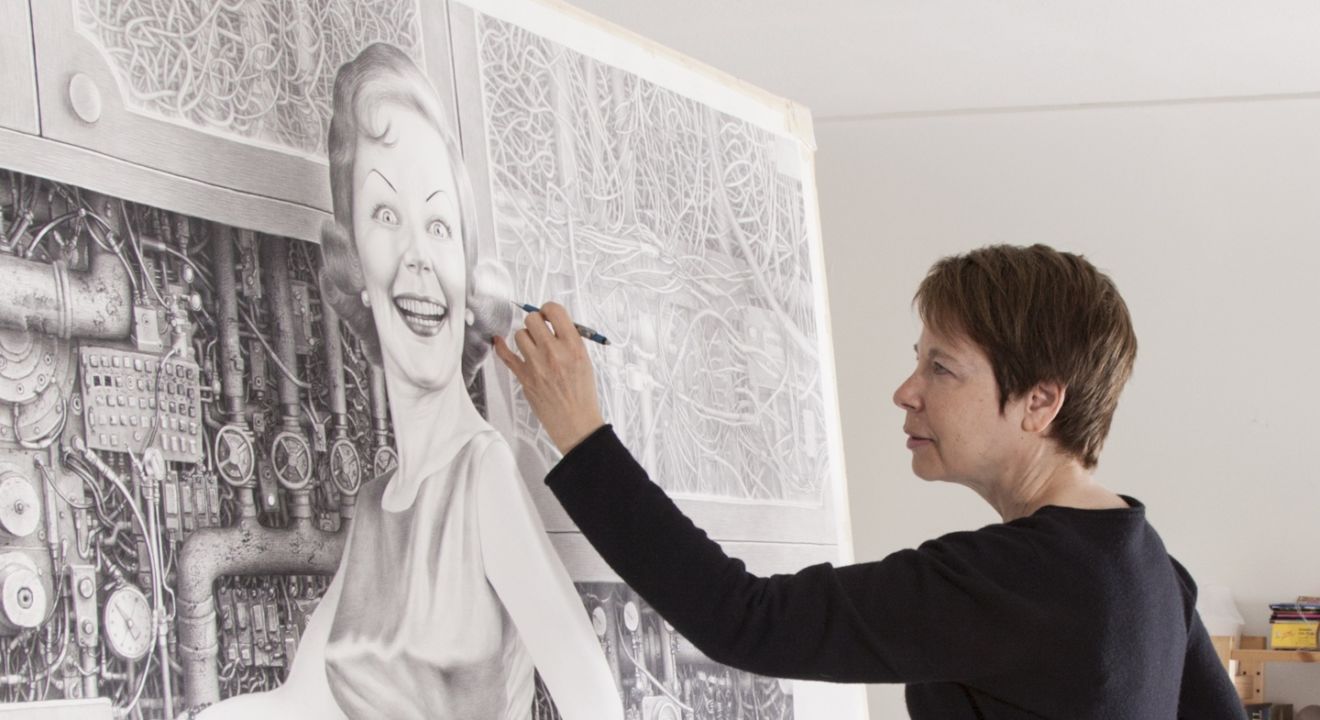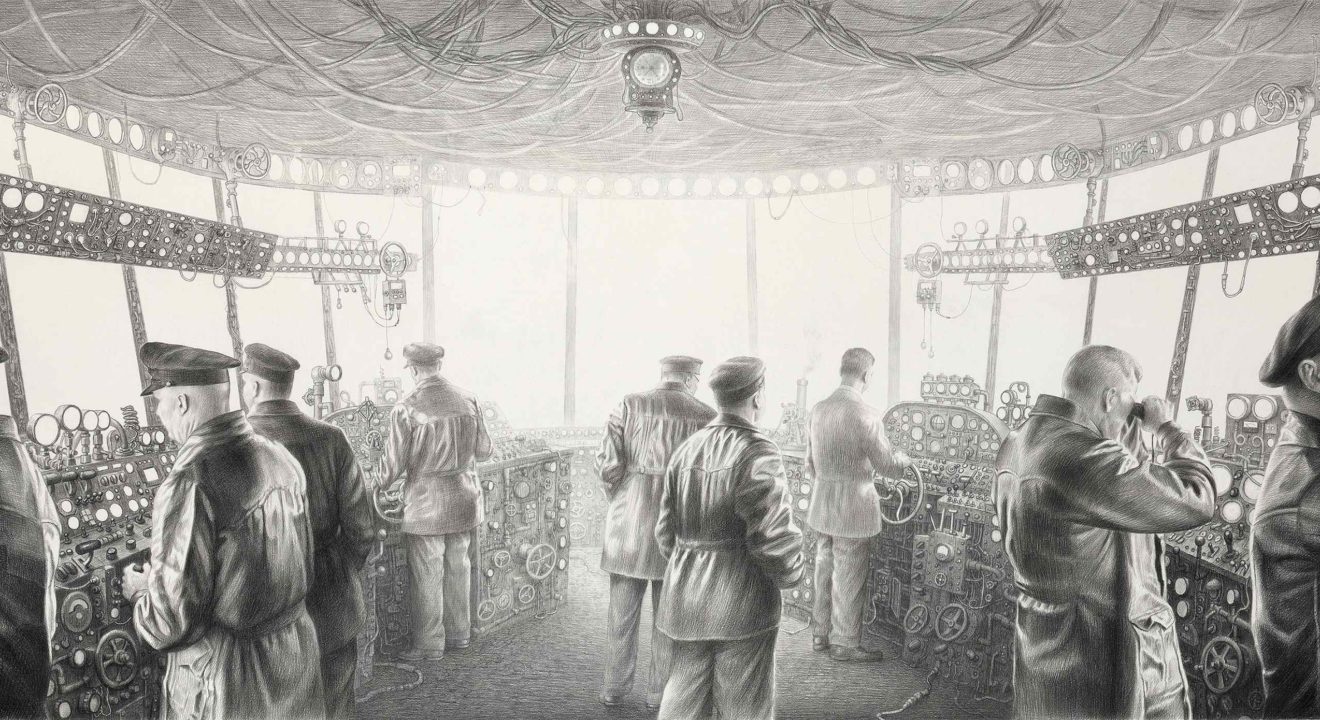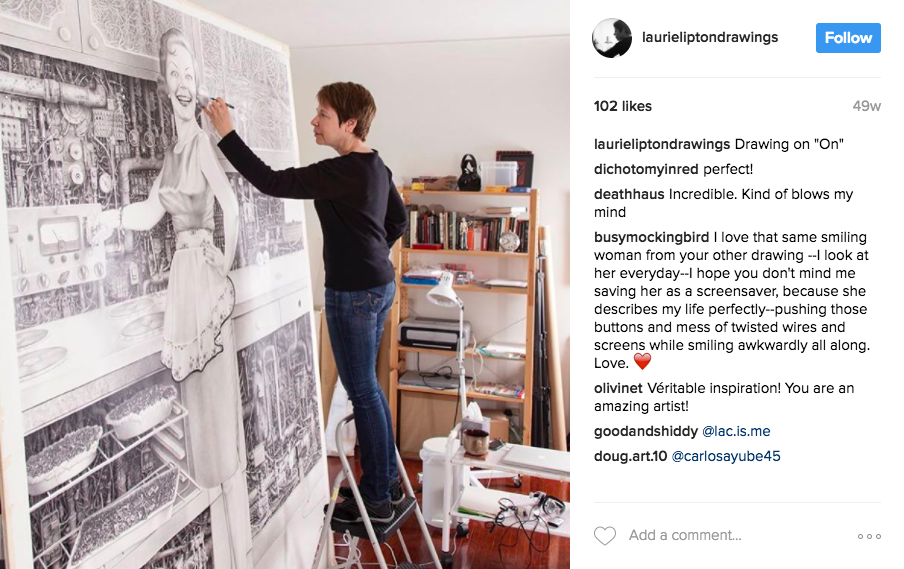Inspiration February 23, 2017


When you hear the term “artwork,” what images pop into your head? Gorgeous abstract landscapes, like Vincent van Gogh’s Starry Night? What about realistic portraits, such as Mona Lisa by Leonardo da Vinci? Most likely, disturbing drawings of technology or death probably aren’t the first images to cross your mind…unless, of course, you’re a fan of Laurie Lipton.
RELATED: Why Female Artists Should Bow Down to Trailblazing Sculptor Louise Nevelson
This artist has been shaking up the art scene for years with her unique medium and even more shocking subject matter. To find out what it really takes to turn topics like terror and technology into art, ENTITY talked to Laurie Lipton herself. Here are five facts you probably don’t know – but should – about Laurie Lipton’s artistic process, inspiration and advice for future female artists.
When you first look at Lipton’s drawings, you’ll probably notice two surprising traits. First, the disturbing imagery – often including skulls and skeletons – that seems to have either a blatant or nuanced presence in all of her drawings. While “Interface” is one of the more nuanced examples, “Death and the Maiden” certainly captures Lipton’s darker side.
Considering that Lipton grew up in the 1950s and 1960s, it may be no surprise that she threads these themes into artwork. In fact, Lipton has previously mentioned turning to artwork to express her anger or painful feelings in the midst of her idillic 1950s childhood. After all, when you think of the 1950s, you might picture the typical 50’s housewife smiling in a pearl necklace, dress and high heels as she retrieves a casserole out of the oven. Through Lipton’s eyes (and artwork), the woman’s smile is menacing, the cupboards are overflowing with wires and screws, and the casserole on the oven rack is actually a car engine.
RELATED: The Wool Whisperer: How Claudy Jongstra Transforms Wool into Artistic Masterpieces
Much of her artwork – like “Happy” and “Wired” – also explores the false happiness people gain from technology. When asked about her goals for those pieces, Lipton said, “I draw about the times I am living in. Technology is a prevalent factor in my life and in the lives of the people around me. I am just reacting, artistically, to it all. If I could tell you, in words, what my ‘message’ is, or my intention, I’d be a writer.”
Whether she’s depicting scenes from the “good ol days” of the 1950s or a “selfie,” complete with a selfie stick, all of Lipton’s work has a common effect: they not only challenge her audiences’ memories and understanding of today’s culture, but also her own.
The second trait you immediately notice in Lipton’s drawings is the unbelievable amount of detail. You could spend hours just examining the folds and wrinkles of her subject’s clothes and marveling at all of the intricacies. According to Lipton, there is no “average” amount of time it takes to complete her work. “Some drawings are 6 foot by 9 foot, some are 9 inches by 12 inches,” explains Lipton. “Some drawings move slowly, some whiz by. I work all day every day. They take as long as necessary.”
RELATED: Why Every Working Woman Should Make Art – According to Art Therapists
Lipton isn’t afraid of putting in however much time it takes to transfer the (often horrifying) images floating in her mind to paper. As Lipton asserts in a preview of “Love Bite,” a documentary about her art: “There is nobody on the planet who’s drawn more than me. Nobody. That’s all I’ve done. I haven’t cooked. I haven’t made children. I’ve just drawn. That’s all I can do – that’s all I do.”
You’ve probably heard the saying, “Practice makes perfect.” Well, when it comes to Laurie Lipton, practice – 24/7 practice, that is – makes for perfectly deep and disturbing artwork.
Turning some of your darkest, innermost fears into gorgeous pieces of artwork takes courage…and Lipton considers her upbringing to be the source of her own. “My parents always praised and never censored me, so I grew up with a lot of self-assurance and courage when it came to my art work,” she told ENTITY.
RELATED: How “Bella Gaia” is Transforming Climate Change Art
When Lipton transforms a blank canvas into her next piece of commentary on technology or modern culture, she doesn’t worry about what people will “get” from it either. As she explained to WOW: “I am not in control of what the viewer thinks, sees or feels when looking at my drawings. Art is a deeply personal, subjective experience. What they bring to my work is not my responsibility. I am only interested in the ‘dialogue’ between me and my piece of paper.”
Maybe you’ll look at a piece like “Default Settings” and be inspired to contemplate how engrained technology has become in people’s everyday lives. Or, maybe you’ll look at it and not think anything – or even have nightmares of a floating skeleton head later that night. Lipton isn’t concerned about your reaction; she just focuses on putting pencil to paper.
It should come as no surprise that work like Lipton’s is rare, but this rarity is due to her medium as much as her subject matter. She sticks to pencil and paper, creating the most detailed and artistic “doodles” you’ve probably ever seen. According to Lipton, “I always drew…from a very early age, probably three or four. I was encouraged, so I continued. The more I drew, the better I became.” And, if you were wondering, yes – even Lipton’s early artwork featured the same troubling imagery you can see today.
RELATED: Alessia Cara and 5 Other Artists Who Got an Early Start in Their Singing Careers
Besides starting to draw from a young age, Lipton also seems to have a natural wiring for art. “I think in images,” she told ENTITY. “I thought that this was normal until my mother told me that people think in words.” This constant bombardment of images in her mind is actually where Lipton draws most of her inspiration.


“The Illusion of Control Tower 2012″, charcoal & &pencil on paper, 56.5″x143”
Photo courtesy of Laurie Lipton
If you look at Lipton’s work and think it would take a unique mind to come up with these unique images…you aren’t that far off!
Although Lipton’s pieces are now exhibited throughout Europe and the U.S., she experienced plenty of bumps and challenges before finding success in the art world. She remembers being told that her “style” was outdated (like, Middle Ages outdated) and that pencils were for outlining artwork, not making it. As Lipton explains on her website, it also took her plenty of experimentation to discover that black and white was the “color of ghosts, longing, time passing, memory and madness” – and therefore the perfect color scheme for her own artwork.
RELATED: 5 Female Artists in the Shade of Their Well-Known Husbands
If you’re dreaming of being an artist like Lipton, you should keep the advice Lipton told ENTITY in mind. “Being an artist is a tough road to travel, and if you’re a woman it’s even tougher,” Lipton says. “Unless you are totally passionate about what are you are doing and willing to spend countless, unpaid hours doing it, then forget about it. Become a CEO of a corporation… or President.”


Laurie Lipton drawing “On” via her Instagram
If you try to “know” Lipton just from looking at her drawings, you probably don’t picture a quaint, put-together woman in her early 60s. But, in a way, Lipton’s identity seems to mirror her own art: both boast a seemingly normal exterior with some surprises underneath. Lipton’s work is an almost like another appendage or organ that, if missing, would leave Lipton incomplete.
The art world would be equally incomplete without Lipton’s unique contribution. After all, what other artist proves that technology and terror, when drawn with the right hand, can be as disturbing as they are beautiful?